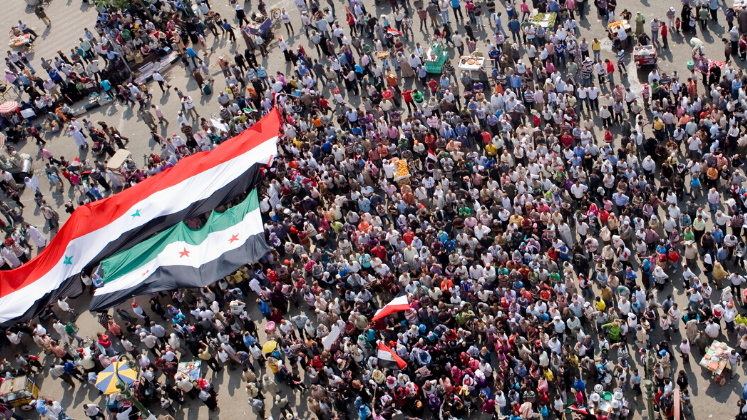In Martyrs and Tricksters, Walter Armbrust contributes to the emerging literature introducing the trickster as a central actor in the political field through an ethnographic analysis of the rise of Abdel Fattah el-Sisi to power in Egypt. Suggesting that political ambivalence can itself be a source of power and rejecting attempts to understand trickster figures through traditional models of hegemony-building, this book will be as useful to students of political sociology as it is to those of revolution, history and the ethnography of the Middle East, writes Hesham Shafick.
Martyrs and Tricksters: An Ethnography of the Egyptian Revolution. Walter Armbrust. Princeton University Press. 2019.
Find this book (affiliate link): ![]()
 Numerous developments on the global scene encourage us to take trickster politics seriously. The abundant examples include, among other things, the unanticipated rise of a once joke-candidate to the office of US President; the successful mobilisation for Brexit through a mixture of demagogic jargon and entirely false information; the consolidation of authoritarianism in Turkey under the pretext of protecting democratic institutions; and the violent termination of Egypt’s nascent democratisation project under slogans of popular legitimacy.
Numerous developments on the global scene encourage us to take trickster politics seriously. The abundant examples include, among other things, the unanticipated rise of a once joke-candidate to the office of US President; the successful mobilisation for Brexit through a mixture of demagogic jargon and entirely false information; the consolidation of authoritarianism in Turkey under the pretext of protecting democratic institutions; and the violent termination of Egypt’s nascent democratisation project under slogans of popular legitimacy.
Walter Armbrust’s Martyrs and Tricksters – an ethnographic analysis of the rise of Marshal Abdel Fattah el-Sisi, the trickster who manoeuvred the revolutionary situation in Egypt to consolidate his authoritarian regime – is amongst the first attempts to theoretically introduce tricksters as central actors in the political field. The trickster, a classical figure in folklore, is typically the wanderer who appears in a village from nowhere and captivates its inhabitants with eccentric opinions and alluring stories. While most scholarship on ‘the trickster’ is cultural, Armbrust argues that tricksters are highly relevant to contemporary politics.
In normal circumstances, tricksters could be objects of ridicule, for the narratives they bring in are, by virtue of them being ‘outsiders’, foreign to what inhabitants already know. But in the condition of liminality – the state of being betwixt and between amidst overwhelming paths and possibilities – trickster narratives could serve as much-needed affirmation. When the conventional signposts of social and political life are dismantled, society is set on an anxious state of non-structure; and the absence of central conventions makes people open to, if not eager to believe, the trickster’s eccentric tales. The power of the trickster, in such cases, lies precisely in their ability to entertain the liminality, never resolving it entirely – for it is the source of their power – but suggesting ideas and possibilities which respond to it.

Interrogating the post-revolution rise of Marshal el-Sisi to the centre of the political field despite, or in fact because of, his position – and continuous positioning – as an ‘outsider’ to it, Armbrust suggests that being politically ambivalent could be in itself a source of power. A telling but widely overlooked fact that Armbrust highlights is that el-Sisi never publicly revealed any political affiliation or even a policy plan. He did not form a political party. He never mentioned his ideological views. He refused to present a plan as a presidential candidate (even warning that he might reconsider not running if the demands for a plan continued). He even continues to refuse to inform the public about his ongoing projects – on one occasion justifying this as an intended strategy to confuse the ‘forces of evil’ that might destroy his projects if they knew about them. By refusing to reveal any political character, el-Sisi keeps all his options open, all the time. Like tricksters in classical folklore, el-Sisi has no ‘home’ in the (political) village. He is a continuous wanderer who flexibly changes his political address in adaptation to contingencies, moving freely amongst the vast possibilities that liminality gives rise to.
Armbrust’s analysis of el-Sisi’s rise to power begins from the January 2011 revolution as the opening scene. Revolution, by definition, is a liminal crisis: a state in which the old is dead and the new is yet to be born. The disturbance of traditional politics that the revolution brought about gave rise to an abrupt state of transition from a political structure that was well-known to one that was yet to be realised. In the early days, this disturbance was productive: not only because it expanded political possibilities, but also because it united the diverse actors who had little in common but their aspiration for something different. The acknowledgement that ‘what is next’ is hard to envisage encouraged revolutionaries to set aside their divergent visions of the future and focus on the ‘here and now’, manifested in their unified rejection of the present. There seemed to be a tacit agreement to take time out of all traditional conflicts until the transition was successfully finished, ‘a time out of time’, as Hanan Sabea eloquently puts it.
But once the removal of President Hosni Mubarak signalled the end of this transition, the earlier ‘communitas’ broke down into various conflicting sub-units: The Supreme Council of Armed Forces (SCAF), the de facto interim ruler, which celebrated the revolution’s success with one hand and stigmatised and violently cracked down those who pushed for more revolutionary action with the other; the octogenarian Muslim Brotherhood that won all the following electoral encounters and was pushing for a prompt transition of power; the nascent non-Islamist political actors worried about the repercussions of the hastened transition; workplace strikers demanding industrial rights; a middle class concerned about the economic downsides of the continued disturbance of daily life by contentious action; and many others. Behind all of that, there was a silent majority confused about the whole enterprise – commonly grouped, with a bit of sarcasm, as the ‘couch potato’ party (indicating their passive approach to politics).

The contentions between these various actors created a need for an arbitrator – and that is when el-Sisi stepped in. With no preset obligations towards a political group, ideology or agenda, he came to the fore as the external saviour: the military bureaucrat who could arbitrate politics from a distance. This perceived distance granted el-Sisi two pivotal competitive advantages. For one, the silent majority found refuge in the de-politicised persona he presents, which many thought would mitigate the complexity and anxiety of the polemical political atmosphere. Second, the fact that he was an outsider to the political field meant that none of the major actors conceived him as a rival. Instead, each approached him as a potential ally; and he was left to pick and choose amongst the various competing options.
The rest was history. Flexibly shifting alliances, el-Sisi played his rivals against one another, until no powerful players were in the political field anymore. In the beginning, he portrayed himself as the change-agent in the military, encouraging the Brotherhood regime to appoint him as defence minister and its champion media to celebrate him as the ‘minister with revolutionary taste’. He then collaborated with the non-Islamist opposition to mobilise against and eventually overthrow the regime that brought him to power. Next, he brought the pre-revolution old guard together with the economically concerned middle-class segments and the politically concerned ‘coach potato’ party, in order to justify his closure of the democratic public sphere, executed with the assistance of the military and security apparatuses. Once the public sphere was closed, he was able to formally become President through theatrical elections. Once President, he got rid of all senior military and security leaders and cracked down on his civilian coup partners (politicians, media personalities, businessmen, etc). By deploying each force to facilitate his crackdown on the other, el-Sisi ended up as the only powerful figure on the political stage.
It was particularly the fact that he was never part of the political stage – and still paradoxically remains outside of it – that made him capable of swinging like a pendulum between its various actors. On 25 February 2020, el-Sisi led Mubarak’s funeral. The image of him passionately giving condolences to the Mubarak family was widely perceived as a belated revelation of his real political identity: a protégé of Mubarak. But it could also be a mere snapshot of one face of a trickster persona whose only consistency is change. The main takeaway of Armbrust’s analysis is that tricksters like el-Sisi, who have no home, no affiliation and no character, are too protean to anticipate.
Martyrs and Tricksters, therefore, should not be read solely as an explanation of El-Sisi’s trickster persona. Mainly, it should be read as a rejection of the possibility of explaining the rise of trickster personalities like El-Sisi, but also Donald Trump, Boris Johnson and Recep Tayyib Erdoğan, through traditional models of hegemony-building. This makes the book as useful to students of political sociology as it is to those of revolution, history and the ethnography of the Middle East.
Note: This review gives the views of the author, and not the position of the LSE Review of Books blog, or of the London School of Economics. The LSE RB blog may receive a small commission if you choose to make a purchase through the above Amazon affiliate link. This is entirely independent of the coverage of the book on LSE Review of Books.
Image One Credit: Cropped image of President Donald J. Trump speaking to the President of the Arab Republic of Egypt Abdel Fattah el-Sisi prior to their bilateral meeting Monday, Sept. 24, 2018, at the Lotte New York Palace in New York. Official White House photo by Shealah Craighead. (The White House, Public Domain).
Image Two Credit: 2011 protest in Tahrir Square, Cairo, Egypt (Hossam el-Hamalawy CC BY SA 2.0).





